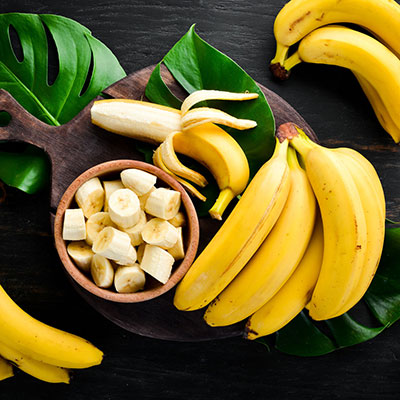Bananas | Whole Food Nutrition
 Bananas are the most consumed fruit in the United States, followed by strawberries and grapes.
Bananas are the most consumed fruit in the United States, followed by strawberries and grapes.
Background
- Banana is a member of the botanical family Musaceae which also includes plantain.
- The banana plant is grown in tropical climates and is one of the most important fruit crops of the world.
Nutrition
- Bananas are an excellent source of vitamin B6, and a good source of vitamin C, manganese, potassium, and fiber.
- Vitamin B6 encourages red blood cell formation, nervous system function, and immune function.
- Vitamin C is an antioxidant that promotes formation of collagen and connective tissue and wound healing.
- Manganese aids in carbohydrate, protein, and cholesterol metabolism.
- Potassium supports heart and nervous system function, muscle contraction, and blood pressure regulation.
- Fiber helps to maintain bowel health and prevent constipation.
How to Purchase, Prepare, and Store
- Bananas are available year-round at grocers.
- Bananas can be found in a variety of ripeness. Green bananas are the least ripe. As they ripen, the outer peel turns yellow and then becomes brown once overripe.
- Overripe bananas can be eaten and are often used in baked good recipes.
- To prepare a banana, remove the outer peel and eat or add to recipes.
- Bananas can be frozen with their outer peel removed and used in smoothie recipes.
- Store bananas at room temperature. To ripen green bananas, place them in a paper bag with an apple.
- Consume bananas fresh or fried. Bananas can be added to breads, cakes, cookies, muffins, or other desert recipes. They can be used raw in pies or puddings.
Banana Nutrition Facts
1 medium banana, raw
- Calories: 105
- Protein: 1.2 g
- Fat: 0.3 g
- Carbohydrate: 26.9 g
- Fiber: 3.07 g
- Calcium: 5.9 mg
- Iron: 0.3 mg
- Magnesium: 31.9 mg
- Phosphorus: 26 mg
- Folate: 23.6 µg
- Vitamin A: 3.54 µg
Via fdc.nal.usda.gov
